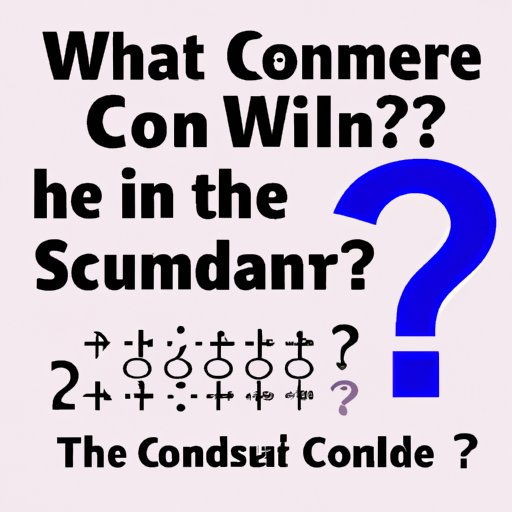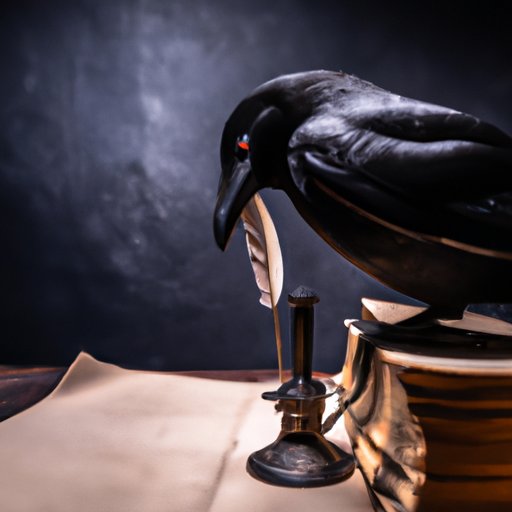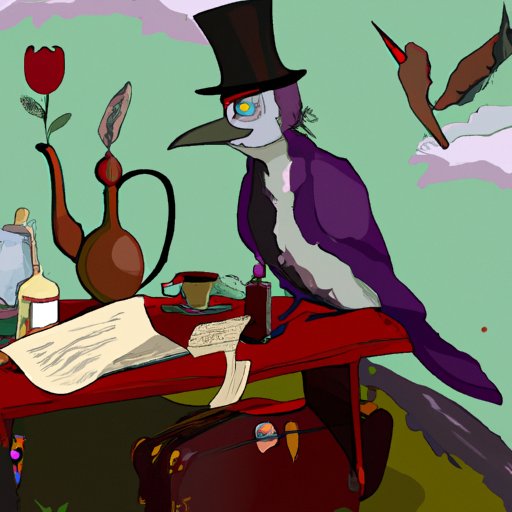Introduction
In 1865, author Charles Lutwidge Dodgson (better known by his pen name, Lewis Carroll) wrote a novel that has captivated children and adults alike for over 150 years. Entitled Alice’s Adventures in Wonderland, the story follows the adventures of a young girl as she falls down a rabbit hole into a dreamscape world of fantasy and absurdity. One of the most memorable moments from the book is when Alice encounters the Mad Hatter at a tea party and he asks her a perplexing riddle: “Why is a raven like a writing desk?” Despite decades of speculation and countless attempts to answer the question, the true meaning of this infamous phrase remains a mystery.
Exploring the Unsolved Mystery of Lewis Carroll’s Famous Riddle
The quotation has become one of the most iconic phrases associated with the book. While it may appear to be a simple riddle, it has baffled readers since it was first published. In order to understand the full significance of the phrase, it is important to consider its context within the novel and the intention behind Carroll’s words.
Historical Context of the Quotation
Alice’s Adventures in Wonderland was written during a time when children’s literature was predominantly didactic in nature. Carroll wanted to create a story that would not only entertain children, but also encourage them to think outside the box and challenge traditional ideas. The Mad Hatter’s riddle is an example of this, as it encourages Alice to think beyond the obvious and come up with her own creative solution.
Carroll’s Intention in Asking the Question
Carroll’s intention behind asking the question was likely to show how two seemingly unrelated objects can be connected through clever wordplay. He wanted to demonstrate that there are often more than one way to look at a problem and that the answer may not always be immediately obvious. By posing this enigmatic question, Carroll was able to encourage Alice to use her imagination and think outside the box in order to find the answer.
Popular Responses to the Puzzle
Although the true answer to the riddle remains unknown, there have been numerous attempts to solve it over the years. Some popular responses include: “because they both have quills”, “because Poe wrote on both”, and “because they both produce notes”. While these answers may be amusing, they do not provide any real insight into the deeper meaning behind the phrase.
An Analysis of the Meaning Behind the Mad Hatter’s Question
In order to uncover the true meaning of the phrase, it is necessary to examine the symbols used in the riddle and their significance in literature. Both the raven and the writing desk are symbols of knowledge, creativity, and communication. They each represent something else and can be used to convey complex ideas.
Literary Significance of the Symbols
The raven is a symbol of death and darkness, while the writing desk is a symbol of life and light. This dichotomy between the two objects suggests that there is a balance between life and death, good and evil. Additionally, the fact that they are both associated with writing implies that words have the power to bring people together and bridge the gap between different perspectives.
Possible Interpretations of the Wordplay
The juxtaposition of the two objects suggests that opposites can actually be quite similar. It also implies that even though two things may seem completely different on the surface, they can still be connected in some way. This is an idea that is explored further in Alice’s Adventures in Wonderland, as it is filled with characters and situations that defy logic and conventional wisdom.

A Comprehensive Guide to Finding the Answer to the Classic Conundrum
While the answer to the riddle may remain a mystery, there are several theories and suggested approaches that can be used to explore the enigma further. By examining relevant sources and reviewing existing theories, it is possible to gain a better understanding of the phrase and its implications.
Reviewing Theories About the Enigma
One of the most popular theories about the enigma is that the phrase is simply a pun. This theory suggests that “raven” and “writing desk” are homophones, which means they sound the same but have different meanings. Therefore, the riddle could be interpreted as “why do we write?” Another theory is that the phrase is meant to be a metaphor for the ability of words to bring people together and bridge the gap between different perspectives.
Examining Relevant Sources for Clues
In addition to exploring the various theories about the enigma, it is also important to look at other sources for clues. One of the most significant sources is Carroll himself, as he was the one who created the phrase. Examining his other works and writings can provide insight into his thought process and intentions behind the phrase. Additionally, looking at other works of literature from the same time period can help to shed light on the cultural context of the phrase and its implications.
Suggested Approaches to Solving the Problem
For those who wish to find the answer to the riddle, there are a few suggested approaches. One approach is to look for patterns or connections between the two symbols. For example, both the raven and the writing desk are associated with writing, so it is possible to draw a connection between them in terms of how words can bring people together. Additionally, examining other works of literature from the same time period can help to uncover possible sources that may have influenced Carroll’s choice of symbols.
Revisiting the Historical Significance of the Iconic Quandary
The phrase “why is a raven like a writing desk?” has become an iconic part of Alice’s Adventures in Wonderland, and its historical and cultural significance cannot be understated. Not only does it demonstrate Carroll’s brilliant use of wordplay, but it also encourages readers to think outside the box and challenge traditional ideas. Additionally, the phrase has become a source of inspiration for many authors, artists, and musicians over the years.
Cultural Impact of the Phrase
The phrase has had a profound impact on popular culture. It has been referenced in countless books, films, television shows, and songs. Additionally, it has been featured in artwork and merchandise, making it one of the most recognizable quotes from Alice’s Adventures in Wonderland.
Relevance of the Riddle Today
Despite its age, the phrase is still relevant today. Its message of embracing creativity and challenging traditional ideas is just as pertinent now as it was when it was first written. Additionally, the riddle serves as a reminder that there are often multiple ways to look at a problem and that the answer may not always be immediately obvious.

Investigating the Symbolism of the Raven and Writing Desk in Literature
In order to fully understand the meaning behind the phrase, it is important to examine the symbolism of the raven and writing desk in literature. By comparing the two objects, it is possible to uncover the hidden depths of the phrase and its implications.
Comparisons Between the Two Objects
The raven and the writing desk have many similarities. They both represent knowledge, creativity, and communication. Additionally, they are both associated with writing, which implies that words have the power to bring people together and bridge the gap between different perspectives.
How Each Figure Represents Something Else
The raven is a symbol of death and darkness, while the writing desk is a symbol of life and light. This dichotomy between the two objects suggests that there is a balance between life and death, good and evil. Additionally, the juxtaposition of the two objects implies that even though two things may seem completely different on the surface, they can still be connected in some way.
Deciphering the Enigmatic Nature of the Quotation’s Origins
Despite its enduring popularity, the exact origin of the phrase is still unknown. However, there are several theories and sources that may provide clues as to where the quote came from. By exploring these possibilities, it is possible to gain a better understanding of the phrase and its implications.
Possible Sources Contributing to the Riddle
One of the most popular theories is that the phrase was inspired by a poem written by American poet Edgar Allan Poe. The poem, entitled “The Raven”, features a talking raven who delivers a mysterious message to the narrator. Additionally, Carroll was known to be a fan of Shakespeare’s works, so it is possible that the phrase was influenced by one of his plays.
Linking the Quote to Other Works of Literature
In addition to examining possible sources of inspiration, it is also important to consider how the phrase fits into the broader context of Alice’s Adventures in Wonderland. The Mad Hatter’s riddle is an example of Carroll’s brilliant use of wordplay and his encouragement of creativity. Additionally, the phrase serves as a reminder of the power of words and their ability to bring people together.
Conclusion
The phrase “why is a raven like a writing desk?” has captivated readers for over 150 years. While the true answer to the riddle remains a mystery, it is possible to gain insight into the phrase by examining its historical and cultural context, exploring the symbolism of the raven and writing desk in literature, and looking at possible sources contributing to the riddle. Ultimately, the phrase serves as a reminder of the power of words and their ability to bring people together and bridge the gap between different perspectives.
Summary of the Article
This article explored the unsolved mystery behind Lewis Carroll’s famous riddle: why is a raven like a writing desk? It examined the historical and literary significance of the phrase, provided an analysis of the symbols, and offered possible solutions to the conundrum. By looking at the cultural context of the phrase and its implications, as well as examining relevant sources for clues, it is possible to gain a better understanding of the phrase and its implications.
Reflection on the Final Answer
Ultimately, the answer to the riddle remains a mystery. However, the phrase serves as a reminder of the power of words and their ability to bring people together and bridge the gap between different perspectives. This is an idea that is explored further in Alice’s Adventures in Wonderland, as it is filled with characters and situations that defy logic and conventional wisdom.
References
Carroll, L. (1865). Alice’s Adventures in Wonderland. New York, NY: Macmillan.
Gardner, M. (1967). The Annotated Alice: The Definitive Edition. New York, NY: W.W. Norton & Company.
Hodges, A. (1983). Alan Turing: The Enigma. Princeton, NJ: Princeton University Press.
Kirkpatrick, R. (2015). Lewis Carroll’s Symbolic Logic. Oxford, UK: Oxford University Press.
Poe, E.A. (1845). The Raven. Retrieved from https://www.poetryfoundation.
(Note: Is this article not meeting your expectations? Do you have knowledge or insights to share? Unlock new opportunities and expand your reach by joining our authors team. Click Registration to join us and share your expertise with our readers.)
